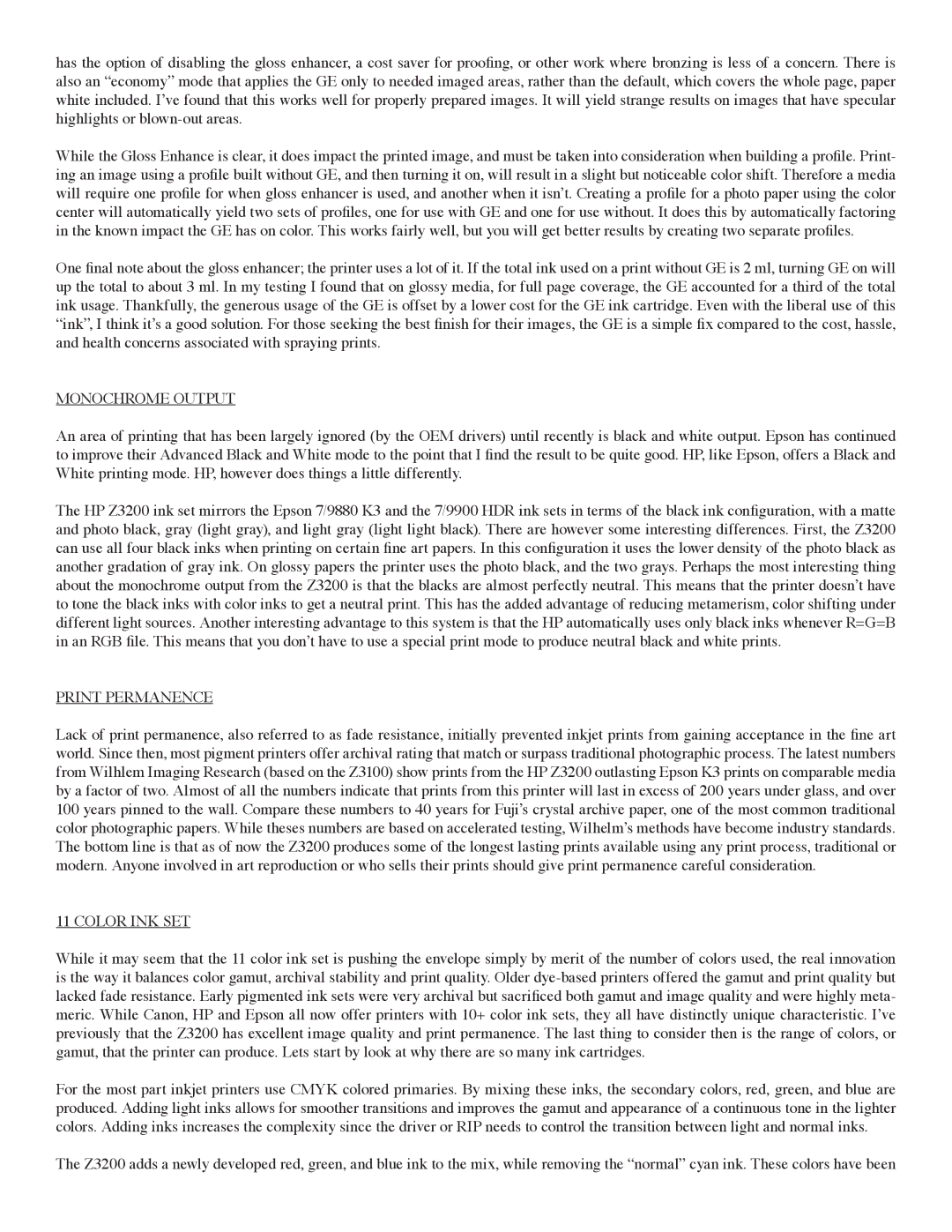has the option of disabling the gloss enhancer, a cost saver for proofing, or other work where bronzing is less of a concern. There is also an “economy” mode that applies the GE only to needed imaged areas, rather than the default, which covers the whole page, paper white included. I’ve found that this works well for properly prepared images. It will yield strange results on images that have specular highlights or
While the Gloss Enhance is clear, it does impact the printed image, and must be taken into consideration when building a profile. Print- ing an image using a profile built without GE, and then turning it on, will result in a slight but noticeable color shift. Therefore a media will require one profile for when gloss enhancer is used, and another when it isn’t. Creating a profile for a photo paper using the color center will automatically yield two sets of profiles, one for use with GE and one for use without. It does this by automatically factoring in the known impact the GE has on color. This works fairly well, but you will get better results by creating two separate profiles.
One final note about the gloss enhancer; the printer uses a lot of it. If the total ink used on a print without GE is 2 ml, turning GE on will up the total to about 3 ml. In my testing I found that on glossy media, for full page coverage, the GE accounted for a third of the total ink usage. Thankfully, the generous usage of the GE is offset by a lower cost for the GE ink cartridge. Even with the liberal use of this “ink”, I think it’s a good solution. For those seeking the best finish for their images, the GE is a simple fix compared to the cost, hassle, and health concerns associated with spraying prints.
Monochrome output
An area of printing that has been largely ignored (by the OEM drivers) until recently is black and white output. Epson has continued to improve their Advanced Black and White mode to the point that I find the result to be quite good. HP, like Epson, offers a Black and White printing mode. HP, however does things a little differently.
The HP Z3200 ink set mirrors the Epson 7/9880 K3 and the 7/9900 HDR ink sets in terms of the black ink configuration, with a matte and photo black, gray (light gray), and light gray (light light black). There are however some interesting differences. First, the Z3200 can use all four black inks when printing on certain fine art papers. In this configuration it uses the lower density of the photo black as another gradation of gray ink. On glossy papers the printer uses the photo black, and the two grays. Perhaps the most interesting thing about the monochrome output from the Z3200 is that the blacks are almost perfectly neutral. This means that the printer doesn’t have to tone the black inks with color inks to get a neutral print. This has the added advantage of reducing metamerism, color shifting under different light sources. Another interesting advantage to this system is that the HP automatically uses only black inks whenever R=G=B in an RGB file. This means that you don’t have to use a special print mode to produce neutral black and white prints.
Print PERMANENCE
Lack of print permanence, also referred to as fade resistance, initially prevented inkjet prints from gaining acceptance in the fine art world. Since then, most pigment printers offer archival rating that match or surpass traditional photographic process. The latest numbers from Wilhlem Imaging Research (based on the Z3100) show prints from the HP Z3200 outlasting Epson K3 prints on comparable media by a factor of two. Almost of all the numbers indicate that prints from this printer will last in excess of 200 years under glass, and over 100 years pinned to the wall. Compare these numbers to 40 years for Fuji’s crystal archive paper, one of the most common traditional color photographic papers. While theses numbers are based on accelerated testing, Wilhelm’s methods have become industry standards. The bottom line is that as of now the Z3200 produces some of the longest lasting prints available using any print process, traditional or modern. Anyone involved in art reproduction or who sells their prints should give print permanence careful consideration.
11 color ink set
While it may seem that the 11 color ink set is pushing the envelope simply by merit of the number of colors used, the real innovation is the way it balances color gamut, archival stability and print quality. Older
For the most part inkjet printers use CMYK colored primaries. By mixing these inks, the secondary colors, red, green, and blue are produced. Adding light inks allows for smoother transitions and improves the gamut and appearance of a continuous tone in the lighter colors. Adding inks increases the complexity since the driver or RIP needs to control the transition between light and normal inks.
The Z3200 adds a newly developed red, green, and blue ink to the mix, while removing the “normal” cyan ink. These colors have been
